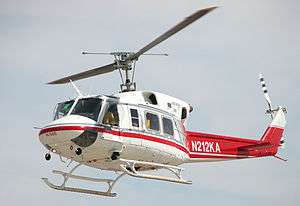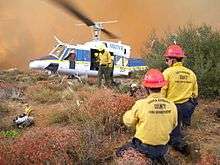Bell 212
| Bell 212 | |
|---|---|
 | |
| Bell 212 operated by Kachina departs from the Mojave Spaceport | |
| Role | Medium helicopter |
| National origin | United States/Canada |
| Manufacturer | Bell Helicopter |
| First flight | 1968 |
| Introduction | 1968 |
| Status | In service |
| Primary user | CHC Helicopter |
| Produced | 1968-1998[1] |
| Developed from | Bell 204/205 |
| Variants | Bell UH-1N Twin Huey Bell 412 |
The Bell 212 (also known as the Twin Two-Twelve) is a two-blade, twin-engine, medium helicopter that first flew in 1968. Originally manufactured by Bell Helicopter in Fort Worth, Texas, United States, production was moved to Mirabel, Quebec, Canada in 1988, along with all Bell commercial helicopter production after that plant opened in 1986.[2][3]
The 212 is marketed to civilian operators and has a fifteen-seat configuration, with one pilot and fourteen passengers. In cargo configuration the 212 has an internal capacity of 220 ft³ (6.23 m³). An external load of up to 5,000 lb (2,268 kg) can be carried.
Development
Based on the stretched fuselage Bell 205, the Bell 212 was originally developed for the Canadian Forces as the CUH-1N and later redesignated as the CH-135. The Canadian Forces took delivery of 50 starting in May 1971. At the same time the United States military services ordered 294 Bell 212s under the designation UH-1N.

By 1971 the 212 had been developed for commercial applications. Among the earliest uses of the 212 in civil aviation was by Helicopter Service AS of Norway to be used in support of offshore oil rigs. Today the 212 can be found used in logging operations, maritime rescue and resupply in the Arctic on the Distant Early Warning Line or North Warning System.
The 212's main rotor is powered by a Pratt & Whitney Canada PT6T-3 Twin-Pac made up of two coupled PT6 power turbines driving a common gearbox. They are capable of producing up to 1,800 shp (1,342 kW). Should one engine fail the remaining engine can deliver 900 shp (671 kW) for 30 minutes, or 765 shp (571 kW) continuously, enabling the 212 to maintain cruise performance at maximum weight.



Early 212s configured with an Instrument Flight Rules (IFR) instrument package were required to have a large and very obvious fin attached to the roof of the aircraft, above and slightly behind the cockpit. This fin was initially determined necessary to alter the turning performance of the aircraft during complex instrument flight maneuvers, but is no longer required due to revised stipulations of the type certificate. Many aircraft still fly with the modification.
In 1979, with the purchase of eight by the Civil Air Authority, the 212 became the first U.S. helicopter sold in the People's Republic of China.
The ICAO designator for this aircraft as used in a flight plan is "B212". Bell developed the Model 212 further with the Bell 412; the major difference being the composite four-blade main rotor. The last Bell 212 was delivered in 1998.[1]
Variants
- Bell Model 212 - Bell Helicopters company designation for the UH-1N.
- Twin Two-Twelve - Civil utility transport version. It can carry up to 14 passengers.
- Agusta-Bell AB 212 - Civil or military utility transport version. Built under license in Italy by Agusta.
- Agusta-Bell AB.212ASW - Anti-Submarine Warfare variant of AB.212
- Bell Model 412 - Bell 212 with a four-bladed semi-rigid rotor system.
- Eagle 212 Single - Single engine variant with a Lycoming T53-17 or T53-BCV engine produced by Eagle Copters of Calgary, Alberta, Canada.[4]
Operators
Civil and government operators

The Bell 212 is used by many private and commercial operators, it is particularly popular in the oil industries and for law enforcement use.
- San Bernardino County Sheriff's Department[13]
- San Diego Fire Department[14]
- Ventura County Sheriff's Department[15]
Specifications (Bell 212)


Data from Bell 212 Rotorcraft Flight Manual[16]
General characteristics
- Crew: 1 (two for IFR operation)
- Capacity: 14
- Length: 57 ft 1.68 in (17.43 m)
- Rotor diameter: 48 ft (14.64 m)
- Height: 12 ft 6.83 in (3.83 m)
- Disc area: 1,809.5 ft² (168.3 m²)
- Empty weight: 6529.4 lb (2961.7 kg)
- Max. takeoff weight: 11,200 lb (5,080 kg)
- Powerplant: 1 × Pratt & Whitney Canada PT6T-3 or -3B turboshaft twin pack, 1,800 shp (1,342 kW)
Performance
- Never exceed speed: 120 knots (138 mph, 223 km/h)
- Maximum speed: 120 knots (138 mph, 223 km/h)
- Cruise speed: 100 knots (115 mph, 186 km/h)
- Range: 237 nm (439 km)
- Service ceiling: 17,400 ft (5,305 m)
- Rate of climb: 1,745 ft/min (532 m/min)
- Disc loading: 6.19 lb/ft² (30.22 kg/m²)
See also
- Related development
- Related lists
References
- 1 2 "Bell 212" (subscription article). Jane's Helicopter Markets and Systems. Jane's Information Group, 2 April 2013.
- ↑ Industry Canada (December 2010). "Bell Helicopter Textron Canada Ltd. - Complete Profile". Retrieved 11 December 2010.
- ↑ Goold, Ian (November 1987). "Canada Seeks Helicopter Self Sufficiency". Flight International. Retrieved 14 December 2010.
- ↑ "Archived copy". Archived from the original on 2013-05-18. Retrieved 2013-03-01.
- ↑ Canadian Coast Guard (17 April 2012). "Coast Guard Rotary Wing Aircraft". Archived from the original on 20 April 2013. Retrieved 4 November 2012.
- ↑ "CH-135 detailed list". rwrwalker.ca. Retrieved 17 April 2015.
- ↑
- ↑ "Greek navy loses AB212 helicopter in training accident". janes.com. Retrieved 12 February 2016.
- ↑ "Japan Coast Guard Bell-212". 海上保安庁 2013 FlyTeam. Retrieved 22 January 2013.
- ↑ "Serbia Police Aviation". aeroflight.co.uk. Retrieved 14 January 2014.
- ↑ "Helikopterji in oprema". policija.si. Retrieved 23 November 2014.
- ↑ "¡Í§ºÔ¹µÓÃǨ ¢èÒÇÊÒÃáÅСԨ¡ÃÃÁ". police.go.th. Retrieved 17 April 2015.
- ↑ "Aircraft Operated". sbcounty.gov. Retrieved 26 July 2013.
- ↑ "Dousing the Flames: San Diego Fire Department Air Ops Program". Access Intelligence, LLC. Retrieved 26 July 2013.
- ↑ "Aircraft N212VC". vcsd.org. Retrieved 26 July 2013.
- ↑ Bell 212 Rotorcraft Flight Manual BHT-212IFR-FM-1 revision 3, 1 May 1998.
Further reading
- Chant, Christopher. Fighting Helicopters of the 20th Century. Graham Beehag Books, Christchurch, Dorset, England (1996).
- Debay, Yves. Combat Helicopters, France: Histoire & Collections (1996).
- Mutza, Wayne. UH-1 Huey in Colors. Carrolton, TX: Squadron Signal. ISBN 0-89747-279-9.
External links
| Wikimedia Commons has media related to UH-1 Twin Huey. |